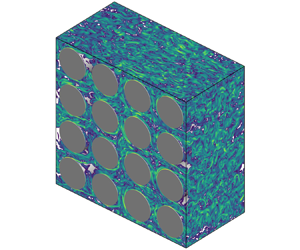Article contents
Symmetry breaking of turbulent flow in porous media composed of periodically arranged solid obstacles
Published online by Cambridge University Press: 19 October 2021
Abstract

The focus of this paper is a numerical simulation study of the flow dynamics in a periodic porous medium to analyse the physics of a symmetry-breaking phenomenon, which causes a deviation in the direction of the macroscale flow from that of the applied pressure gradient. The phenomenon is prominent in the range of porosity from 0.43 to 0.72 for circular solid obstacles. It is the result of the flow instabilities formed when the surface forces on the solid obstacles compete with the inertial force of the fluid flow in the turbulent regime. We report the origin and mechanism of the symmetry-breaking phenomenon in periodic porous media. Large-eddy simulation (LES) is used to simulate turbulent flow in a homogeneous porous medium consisting of a periodic, square lattice arrangement of cylindrical solid obstacles. Direct numerical simulation is used to simulate the transient stages during symmetry breakdown and also to validate the LES method. Quantitative and qualitative observations are made from the following approaches: (1) macroscale momentum budget and (2) two- and three-dimensional flow visualization. The phenomenon draws its roots from the amplification of a flow instability that emerges from the vortex shedding process. The symmetry-breaking phenomenon is a pitchfork bifurcation that can exhibit multiple modes depending on the local vortex shedding process. The phenomenon is observed to be sensitive to the porosity, solid obstacle shape and Reynolds number. It is a source of macroscale turbulence anisotropy in porous media for symmetric solid-obstacle geometries. In the macroscale, the principal axis of the Reynolds stress tensor is not aligned with any of the geometric axes of symmetry, nor with the direction of flow. Thus, symmetry breaking in porous media involves unresolved flow physics that should be taken into consideration while modelling flow inhomogeneity in the macroscale.
- Type
- JFM Papers
- Information
- Copyright
- © The Author(s), 2021. Published by Cambridge University Press
References
Srikanth et al. Supplementary Movie 1
Time series of instantaneous flow streamlines projected on the xy- plane overlaid on static pressure contours at the plane z = 0, showing the transient stages of symmetry-breaking from Rep = 300 to 489 for a porosity φ = 0.5.
Srikanth et al. Supplementary Movie 2
Time series of 3D coherent turbulent structures visualized using the Q- criterion overlaid on instantaneous flow streamlines and static pressure contours at the plane z = 0, showing the transient stages of symmetry-breaking from Rep = 300 to 489 for a porosity φ = 0.5.
- 5
- Cited by



